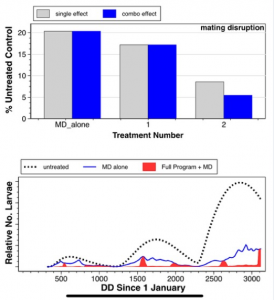Written by Matthew Jones, Manager & Educator for the WSU Decision Aid System, TFREC-Wenatchee. October 2020
Now that the growing season is coming to a close, you might be wondering what parts of your pest management program worked well, and which could use some improvement. If you have questions about whether you (or your orchard manager/consultant) applied sprays at the most opportune times, or which applications in your spray program had the greatest effect on the pest population, now would be a great time to use the WSU Spray Record Evaluator.

Because each pest is most susceptible at certain stages of its development, the timings of sprays targeting those life-stages is critical, as is getting the treatments applied in a timely fashion. By hitting these targets, a grower can get better suppression of pest populations, especially in the first generation. This suppression of the early generations will perpetuate through subsequent generations, having a lasting effect throughout the season. Getting the timing right on these sprays is critical no matter if you’re an organic or conventional grower. Correct timing can help reduce unnecessary sprays, ultimately saving time, money, and most importantly, unnecessary damage to natural enemies. In reality, nailing all the perfect spray timings throughout a growing season is easier said than done. Even when a program works well, growers can be left wondering which sprays in their program were key to archiving control, which sprays were “extra” (or unnecessary), and what windows of opportunity for control were missed.
For this reason, Vince Jones and collaborators developed the WSU Pesticide Spray Record Evaluator (https://pesticides.decisionaid.systems/, Figure 1). This tool is based on the phenology models developed by WSU for use in the Decision Aid System (https://decisionaid.systems/).

To use the tool, a user must: 1) choose which past year of the spray program they would like to evaluate, 2) select which local AgWeatherNet (https://weather.wsu.edu/) weather station is closest to the orchard they work in, 3) select the target pest of the spray program. Together, these variables generate a place-specific degree day model of an unmanaged control population, which the effectiveness of the spray program will be measured against. Next, it’s time to input your spray records. This includes 1) the date a material was actually applied, 2) which material was used (oil, a conventional spray, entrust, or CM Granulosis Virus or Bt depending on the target pest), 3) the length of the residue period (5-17 days depending on material and target pest), and 4) the quality of that specific sprays coverage (poor, good, or excellent). These variables calculate the proportion of the overall pest population that was killed relative to the control population. After inputting the spray records, a user will then hit the “run model” button to generate the results. Note: we DO NOT store any spray records entered onto our site. Records are stored on your browser cache and used when you run the model. We never see them and have no ability to monitor your spray program!
The output produced by the tool gives you multiple pieces of information. First, piece of information provided by the tool are tables and figures showing how important each spray of the program was both individually, and in combination with the other sprays (and with or without Mating Disruption, if that applies to the pest of interest)(see Figure 2). By providing a breakdown of how each spray contributed to the program, the tool allows for each spray to be critiqued as to how useful it was on its own, and as a part of the overall control program. Additionally, figures are provided showing the suppression of the pest throughout the season.

The second piece of output that is provided is a figure which shows the timing of each spray relative to the pest development throughout the season (Figure 3). This allows you to understand which part of each generation was affected by each spray. This allows the grower to see if sprays overlapped (redundant) or if windows of control opportunity were missed. In figure 3, you can see small window of uncontrolled codling moth egg hatch between 522 DD and 560 DD (of a codling moth population) and the lack of sprays in the latter part of the first generation. The important thing to remember when looking at this figure is that the reproductive adults that develop from this missed control windows will contribute to the individuals mating and laying eggs in subsequent generations.
Lastly, for each pest, there is a guidance section that summarizes the best management practices for the optimal control of each of the six pests we have models for. For further information about how to use this tool, click the “About” tab at the top of the site’s page. It is our hope that you will use this tool to help fine-tune your pest management program for next year!
Contact
 Matthew Jones
Matthew Jones
Research Assistant Professor
Manager/Educator WSU Decision Aid System
TFREC, Wenatchee, WA
email: matthew.s.jones@wsu.edu
treefruit.wsu.edu articles may only be republished with prior author permission © Washington State University. Republished articles with permission must include: “Originally published by Washington State Tree Fruit Extension at treefruit.wsu.edu” along with author(s) name, and a link to the original article.
